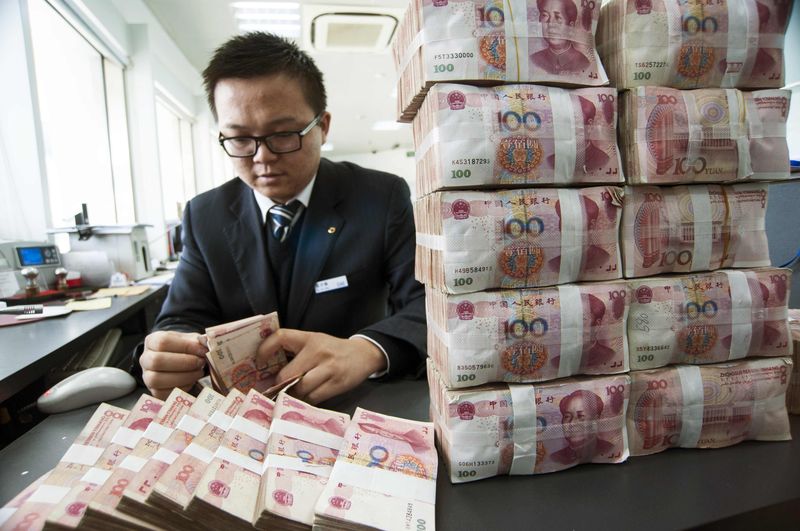BEIJING (Reuters) - China's foreign exchange reserves rose in May for a fourth consecutive month and by more than markets had expected, as stringent capital control measures and a weakening in the dollar helped staunch outflows.
Reserves rose $24 billion in May to a seven-month high of $3.054 trillion, compared with an increase of $21 billion in April, central bank data showed on Wednesday.
It was the first time since June 2014 that reserves climbed for four months in a row, and the biggest gain since reserves moved back above the closely watched $3 trillion level in February.
Economists polled by Reuters had expected reserves to rise $10 billion.
A weaker U.S. dollar boosted the value of other currencies and assets held by China in May, the State Administration of Foreign Exchange (SAFE) said in a statement explaining the rise.
Foreign exchange supply and demand was basically balanced in the month, it added.
In May, the dollar recorded its largest monthly percentage loss against a basket of major currencies (DXY) since January.
Tighter restrictions on taking funds out of the country imposed in recent months continue to keep a lid on capital outflows, said Zhou Hao, a Singapore-based analyst at Commerzbank (DE:CBKG).
"From their perspective, they have done a very successful job."
Apart from valuation effects, Capital Economics' Julian Evans-Pritchard said China's central bank may also have been purchasing small quantities of foreign currencies again in May after having sold forex to shore up the sagging yuan for 18 straight months.
"This a major shift in policy that has been achieved thanks to an easing of capital outflows," he said.
"Given our forecast for China’s May trade balance (due out on Thursday), today’s figures still point to capital outflows of around $10 billion last month. But this is down from $30 billion in April and $65 billion at the end of last year."
TURNING THE TIDE?
In April, net foreign exchange sales by the People's Bank of China (PBOC) fell to the lowest in nearly two years as capital outflows eased in the face of strict regulatory curbs and a pause in the dollar's rally.
The forex regulator said last month that China's current cross-border capital flows are stabilizing, but debt risks and signs of slowing economic growth have forced policymakers to keep a tight leash on outflows.
China burned through nearly $320 billion of reserves last year but the yuan still fell about 6.5 percent against the dollar, its biggest annual drop since 1994.
After steadying early this year, the yuan <CNY=CFXS> suddenly bolted to near seven-month highs in recent weeks after the central bank changed the way it calculates its official daily reference point to quash expectations of further depreciation and outflows as the U.S. raises interest rates.
The uncharacteristically rapid appreciation engineered by Chinese authorities were also seen as a show of strength and a warning to speculators after the country's credit rating was downgraded by Moody's on May 24.
The moves have prompted some investment banks to scale back views of yuan weakness this year, with some now saying it could end 2017 relatively unchanged.
In further evidence that Beijing remains concerned about a resurgence of outflows, the foreign exchange regulator announced last Friday that Chinese banks would be required to report daily on bank card holders' overseas transactions exceeding 1,000 yuan ($147).
To be sure, veteran China watchers have cautioned that Chinese companies and individuals would find ways around the capital controls eventually.
Indeed, French investment bank Natixis said in a report that its capital flow tracker for China showed outflows for the second quarter will rise somewhat, reversing the trend in the first quarter.
But while moves to stabilize the yuan may have reassured China's financial markets, they have come at a price.
Persistent depreciation fears along with China's tighter capital controls and currency interventions have dealt a setback to Beijing's ambitions to make the yuan a global currency.
On Wednesday, a central bank advisor said China should urgently reform its foreign exchange rate system or risk impeding the economy and plans for the yuan to play a larger role on the global stage.
Huang Yiping, a member of the central bank's monetary policy committee, told a forum in Beijing that an inflexible foreign exchange rate would limit the opening of the economy and yuan internationalization.
The yuan has slipped to the seventh-most actively traded currency for global trade finance, transaction service provider SWIFT said.
Some Western firms have also been concerned about their ability to remit profits and dividends from China.
The value of gold reserves fell to $75.004 billion at the end of May, from $75.019 billion at end-April, data published on the People's Bank of China website also showed.
